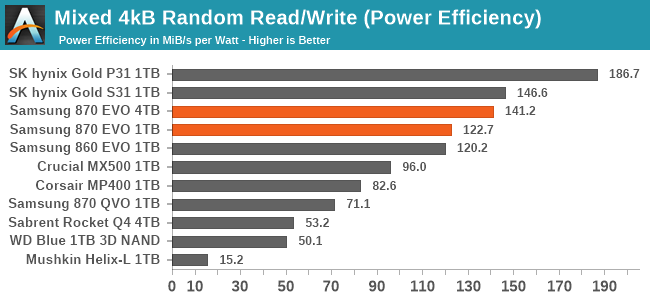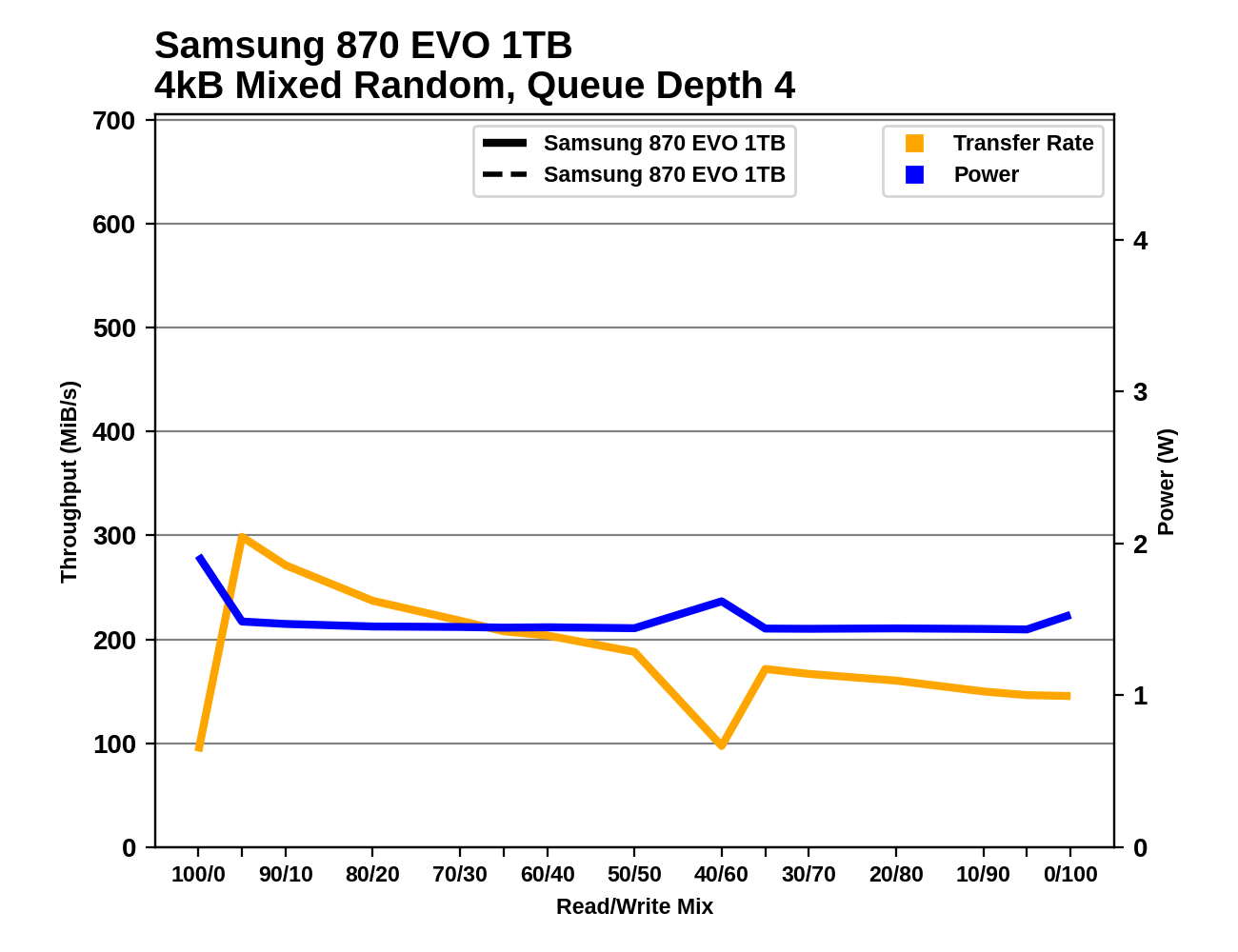The Samsung 870 EVO (1TB & 4TB) Review: Does the World Need Premium SATA SSDs?
by Billy Tallis on February 17, 2021 8:00 AM ESTMixed IO Performance
For details on our mixed IO tests, please see the overview of our 2021 Consumer SSD Benchmark Suite.
 |
|||||||||
| Mixed Random IO | Mixed Sequential IO | ||||||||
The mixed random IO test provides the Samsung 870 EVO with one of its biggest performance wins yet over the rest of the SATA field and the entry-level NVMe competition. But most of that comes from the capacity advantage the 4TB model has over most of these comparison drives; the 1TB 870 EVO is only about 5% faster overall than the 860 EVO. On the mixed sequential IO test, the SATA bottleneck keeps most of the performance scores within a fairly narrow range, and the 1TB 870 EVO's performance is actually a bit of a regression compared to its predecessor.
 |
|||||||||
| Mixed Random IO | Mixed Sequential IO | ||||||||
As with our separate tests of random reads and writes, the top efficiency scores for mixed random IO go to SK hynix, with Samsung's TLC drives turning in the next best scores and having a clear advantage over other competing brands. Over on the sequential IO side of things, the efficiency scores more closely mirror the performance scores, and the 870 EVO doesn't have any real advantage over other mainstream SATA drives.
 |
|||||||||
| Mixed Random IO | |||||||||
| Mixed Sequential IO | |||||||||
The 1TB 870 EVO's performance during the mixed random IO test is more consistent than the 860 EVO's, but still has a few unpleasant drops that aren't present for the 4TB model. On the mixed sequential IO test, the 1TB 870 EVO's performance is actually a bit less consistent than the 860 EVO. But aside from those occasional outliers, the general trend is for the 870 EVO to provide superior random IO performance and link-saturating sequential performance across a wide range of workload mixes.
Idle Power Management
Real-world client storage workloads leave SSDs idle most of the time, so the active power measurements presented earlier in this review only account for a small part of what determines a drive's suitability for battery-powered use. Especially under light use, the power efficiency of a SSD is determined mostly be how well it can save power when idle.
SATA SSDs are tested with SATA link power management disabled to measure their active idle power draw, and with it enabled for the deeper idle power consumption score and the idle wake-up latency test. Our testbed, like any ordinary desktop system, cannot trigger the deepest DevSleep idle state. For more details, please see the overview of our 2021 Consumer SSD Benchmark Suite.


The Samsung 870 EVO may feature an updated controller compared to the 860 EVO, but there's no real difference in idle power consumption, for either active idle or the desktop (non-DevSleep) idle states. Samsung's idle power figures are best in class, with SK hynix offering the only close competition.

The Samsung SATA drives all take about one millisecond to wake up from using SATA link power management. This is higher than several of the other SATA drives, but not really enough to be of much concern for system responsiveness.










136 Comments
View All Comments
Wereweeb - Wednesday, February 17, 2021 - link
They made a major update. No one cares about SATA Express. That you don't even know about it only goes to show that no one cares, there's no need or use for it.SATA is plenty enough for Hard Drives, and SSD's are going to keep using M.2, U.3, and other PCIe ports. There's no need for a port that isn't going to be used by anyone.
If anything, they could theoretically run spinning rust off an x1 PCIe 3.0 (Or even 2.0) connector, but that's also not really needed.
If you want consumer motherboards to have U.3 connectors, then say that. And I'd agree. I never like bare PCB's where they're not necessary.
Lord of the Bored - Wednesday, February 17, 2021 - link
I ABSOLUTELY want U.2 connectors on motherboards, and U.2 drives priced for mass-market sales.It won't happen, because the manufacturers want a hard line drawn between home-use and business-use hardware so they can price-gouge for business hardware. Mass-market U.2 drives would ruin their pricing strategy.
Wereweeb - Thursday, February 18, 2021 - link
They don't really need to, consumer SSD's are already shit for most enterprise applications, and will be plain garbage when it's all just QLC.Billy Tallis - Thursday, February 18, 2021 - link
Consumer U.2 drives wouldn't ruin the enterprise SSD market, because the form factor is a much less important difference than the fact that consumer SSDs have SLC caching and enterprise SSDs don't.Consumer U.2 drives would fail because the market is simply too small. The number of consumers who can actually afford and want 3+ NVMe SSDs in their desktop (and aren't already on a HEDT system) is too small to justify bringing a new category of products to market.
Spunjji - Friday, February 19, 2021 - link
Changing the SATA standard in a way that wrecks backwards compatibility would be pointless - U.2 is already an alternative standard that does that.It's dead. It's a silly way to access flash devices.
Gigaplex - Wednesday, February 17, 2021 - link
Or they'd just switch to using SAS in those devices.flyingpants265 - Thursday, February 18, 2021 - link
The suggestion for hard drives was to double the amount of heads/platters per drive to get costs down even further, I think this decreases reliability too but reduces overhead costs for datacenters because it's fewer drives.8 tb, 10 TB and 12 TB drives are more expensive per gb than the two terabyte drives.... Prices haven't gone down since 2010. I should be able to walk in and get a 8tb drive for $89. The markets really crapped out.
Spunjji - Friday, February 19, 2021 - link
HDD prices never really recovered after the 2011 floods in Thailand. By the time the impact was over, SSDs were eating their lunch, and the incentive to keep dropping prices went away forever.Jorgp2 - Wednesday, February 17, 2021 - link
SAS connectors provide power and up to 4x PCI-E lanes.Kevin G - Wednesday, February 17, 2021 - link
At the time SATA was developed, it made sense. Times of course have changed with SATA now feeling more of a legacy technology. It'll continue to hang around as the protocols it was built upon (AHCI etc.) are present in legacy OS where as NVMe support may not be there. Similarly there is no support for removable media though leveraging USB for that now is trivial. Main barrier for the formal death of SATA is still cost as NVMe still carries a slight premium over SATA and consumer systems have limited PCIe connectivity.